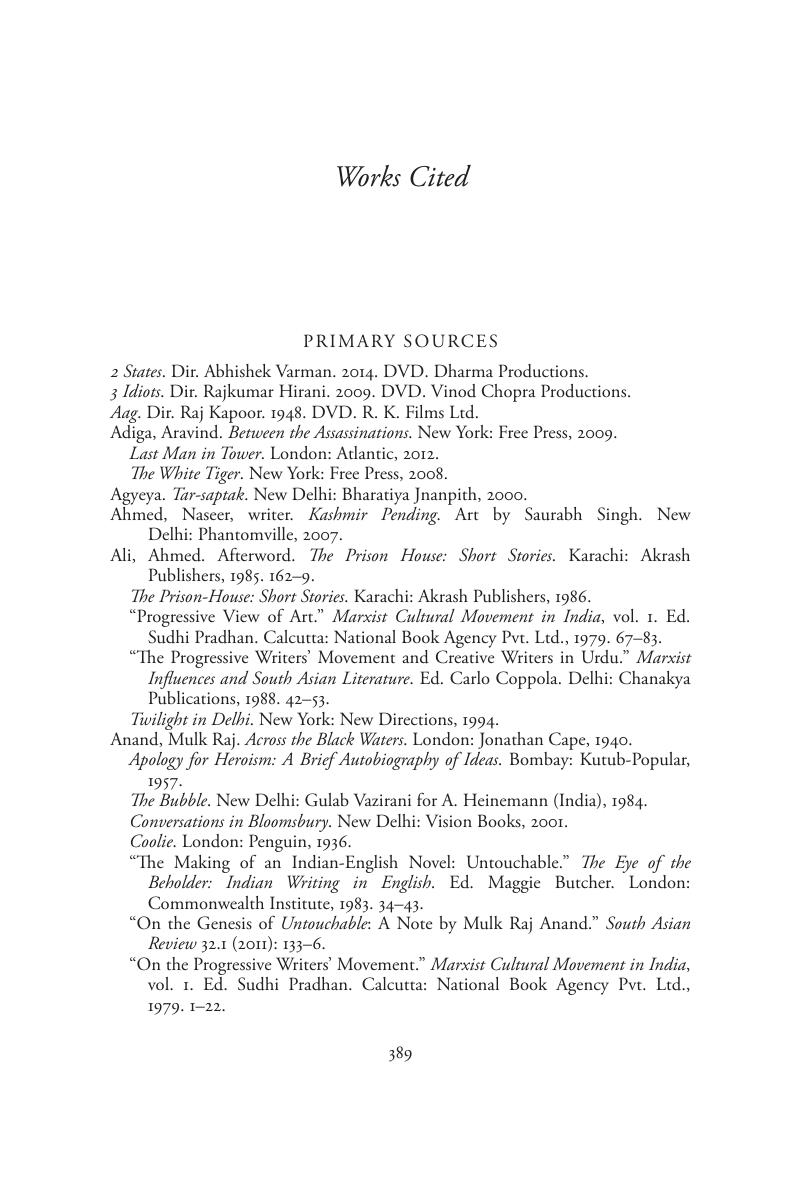Book contents
- Frontmatter
- Contents
- List of Figures
- Notes on Contributors
- Acknowledgments
- Introduction: Literary Pasts, Presents, and Futures
- 1 Beginnings: Rajmohan's Wife and the Novel in India
- 2 The Epistemic Work of Literary Realism: Two Novels from Colonial India
- 3 “Because Novels Are True, and Histories Are False”: Indian Women Writing Fiction in English, 1860–1918
- 4 When the Pen Was a Sword: The Radical Career of the Progressive Novel in India
- 5 The Road Less Traveled: Modernity and Gandhianism in the Indian English Novel
- 6 The Modernist Novel in India: Paradigms and Practices
- 7 “Handcuffed to History”: Partition and the Indian Novel in English
- 8 Women, Reform, and Nationalism in Three Novels of Muslim Life
- 9 Found in Translation: Self, Caste, and Other in Three Modern Texts
- 10 Emergency Fictions
- 11 Cosmopolitanism and the Sonic Imaginary in Salman Rushdie
- 12 Postcolonial Realism in the Novels of Rohinton Mistry
- 13 Far from the Nation, Closer to Home: Privacy, Domesticity, and Regionalism in Indian English Fiction
- 14 Ecologies of Intimacy: Gender, Sexuality, and Environment in Indian Fiction
- 15 Some Uses of History: Historiography, Politics, and the Indian Novel
- 16 Virtue, Virtuosity, and the Virtual: Experiments in the Contemporary Indian English Novel
- 17 Of Dystopias and Deliriums: The Millennial Novel in India
- 18 “Which Colony? Which Block?”: Violence, (Post-)Colonial Urban Planning, and the Indian Novel
- 19 Post-Humanitarianism and the Indian Novel in English
- 20 Chetan Bhagat: Remaking the Novel in India
- 21 “New India/n Woman”: Agency and Identity in Post-Millennial Chick Lit
- 22 The Politics and Art of Indian English Fantasy Fiction
- 23 The Indian Graphic Novel
- 24 “Coming to a Multiplex Near You”: Indian Fiction in English and New Bollywood Cinema
- 25 Caste, Complicity, and the Contemporary
- Works Cited
- Index
- References
Works Cited
Published online by Cambridge University Press: 05 August 2015
- Frontmatter
- Contents
- List of Figures
- Notes on Contributors
- Acknowledgments
- Introduction: Literary Pasts, Presents, and Futures
- 1 Beginnings: Rajmohan's Wife and the Novel in India
- 2 The Epistemic Work of Literary Realism: Two Novels from Colonial India
- 3 “Because Novels Are True, and Histories Are False”: Indian Women Writing Fiction in English, 1860–1918
- 4 When the Pen Was a Sword: The Radical Career of the Progressive Novel in India
- 5 The Road Less Traveled: Modernity and Gandhianism in the Indian English Novel
- 6 The Modernist Novel in India: Paradigms and Practices
- 7 “Handcuffed to History”: Partition and the Indian Novel in English
- 8 Women, Reform, and Nationalism in Three Novels of Muslim Life
- 9 Found in Translation: Self, Caste, and Other in Three Modern Texts
- 10 Emergency Fictions
- 11 Cosmopolitanism and the Sonic Imaginary in Salman Rushdie
- 12 Postcolonial Realism in the Novels of Rohinton Mistry
- 13 Far from the Nation, Closer to Home: Privacy, Domesticity, and Regionalism in Indian English Fiction
- 14 Ecologies of Intimacy: Gender, Sexuality, and Environment in Indian Fiction
- 15 Some Uses of History: Historiography, Politics, and the Indian Novel
- 16 Virtue, Virtuosity, and the Virtual: Experiments in the Contemporary Indian English Novel
- 17 Of Dystopias and Deliriums: The Millennial Novel in India
- 18 “Which Colony? Which Block?”: Violence, (Post-)Colonial Urban Planning, and the Indian Novel
- 19 Post-Humanitarianism and the Indian Novel in English
- 20 Chetan Bhagat: Remaking the Novel in India
- 21 “New India/n Woman”: Agency and Identity in Post-Millennial Chick Lit
- 22 The Politics and Art of Indian English Fantasy Fiction
- 23 The Indian Graphic Novel
- 24 “Coming to a Multiplex Near You”: Indian Fiction in English and New Bollywood Cinema
- 25 Caste, Complicity, and the Contemporary
- Works Cited
- Index
- References
Summary

- Type
- Chapter
- Information
- A History of the Indian Novel in English , pp. 389 - 424Publisher: Cambridge University PressPrint publication year: 2015

